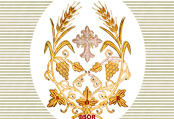
 |
|
||
| Mor Toma |
|
St. Thomas thrusting his fingers into the wounds of the Risen Christ, depicted in a Gospel Lectionary copied in Salah in 1227 for the church of Mor Sobo in Hah. One of the Twelve Apostles, St. Thomas is prominent in the Syriac tradition. He is mentioned in all four Gospels. In St. John, he appears in three episodes, namely offering to die with Jesus on His way to Bethany (Jn 11:16), interrupting the last discourse with his question, "Lord, we do not know where you are going, and how can we know the way" (Jn 14:5) and, lastly, doubting the Ressurection unless he were to touch the wounds of the Risen Lord (Jn 20:25-8). After Christ's appearance he confesses his faith in the words, 'My Lord and my God' and is thus the first to confess His Divinity explicitly. According to an early tradition mentioned by Eusebius (Historia Ecclesiastica 3.I) and others, the Apostle evangelized the Parthians. According to the Gnostic Acts of Thomas in Syriac, where he is called Judas Thomas, he brought the Gospels to India where he was martyred and then buried at Mylapore, near Chennai (Madras). It is believed that the Apostle arrived in India in AD 52 and was martyred in AD 72. The Syriac Christians of Malabar, the Southwest coast of India, call themselves 'Christians of St. Thomas'. It is believed that his body was transferred to Edessa in the 4th century; St. Ephrem's works note that the bones of St. Thomas were venerated there in his time. The great hymnodist alludes to the transferral of the bones in his Carmina Nisibena (42:1.1-2.2, Kathleen McVey, Ephrem the Syrian, Paulist Press, 1989, p. 25):
His relics were moved from Edessa later and rediscovered in this century at the Syriac Orthodox Church of Mosul by His Holiness Mor Ignatius Zakka I while he was the Archbishop of Mosul. There are a number of apocryphal writings under his name, most notably the Acts of St. Thomas which is of Syriac origin. This work dates back to the middle of the 3rd century. Translations in Greek, and portions in Latin, Ethiopic and Armenian exist. The Church commemorates the memory of St. Thomas on July 3rd. The date marks the transfer of the remains of the Apostle to Edessa. The Church in India also commemorates the Apostle on the New Sunday after Easter, on December 18th when the Apostle is believed to have been speared, and on December 21st when he attained martyrdom. Patriarch H.H. Ignatius Zakka I in an encyclical dated October 20, 1987,
added the name of "Apostle Thomas, the preacher of the Holy Gospel of
our Lord Jesus Christ in India" to the the fourth diptych (Syr. tubden)
in the Malankara Church. Source: The Oxford Dictionary of the Christian Church, 3rd ed. (1997). Kathleen McVey, Ephrem the Syrian Hymns (Paulist Press, 1989). |
| Copyright © Syriac Orthodox Resources. All Rights Reserved. |
| Last Update: July 6, 2000 |